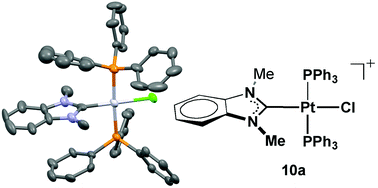N,N-Dialkylbenzimidazol-2-ylidene platinum complexes – effects of alkyl residues and ancillary cis-ligands on anticancer activity†
Abstract
Eleven complexes of [(1,3-dialkylbenzimidazol-2-ylidene)LnCl3−n]Pt(n−1)+, with Ln = DMSO (8), Ph3P (9), (Ph3P)2 (10), and alkyl = Me (a), Et (b), Bu (c), octyl (d), were synthesised and tested for cellular accumulation, cytotoxicity, interference with the tumour cell cycle, and interaction with DNA. The delocalised lipophilic cationic bisphosphane complexes 10 were on average found to be more cytotoxic in MTT assays against a panel of seven cancer cell lines than the neutral DMSO and monophosphane complexes 8 and 9. The uptake of complexes 10, at least into HCT116 colon carcinoma cells, was also significantly greater than that of analogues 8 and 9. Their cytotoxicities did not differ significantly with the N-alkyl side chain length. The complexes that were most active, with sub-micromolar IC50 (72 h) values against HCT116wt cells, that is 8b, 9b, 10a–c, worked by a mode of action that was dependent on the functional p53, yet were still far more active than cisplatin in both of the HCT116wt and HCT116−/− variants. In detailed binding analyses 8c, 9c and 10a–c showed a lower affinity to DNA and different binding modes when compared to cisplatin, preferably forming mono-adducts with DNA and distorting it to a lower extent. Also, unlike cisplatin, they arrested the HCT116 cells of both variants predominantly in the G1 phase.



 Please wait while we load your content...
Please wait while we load your content...